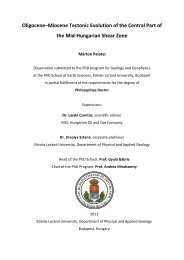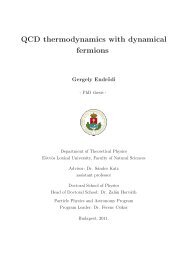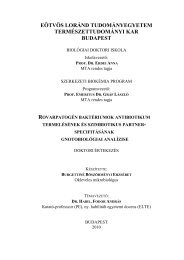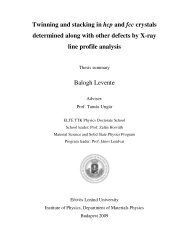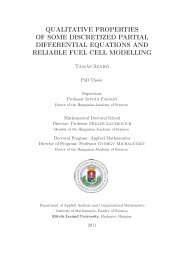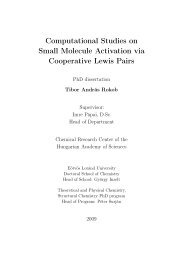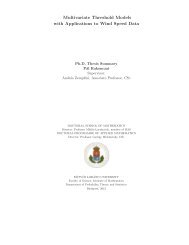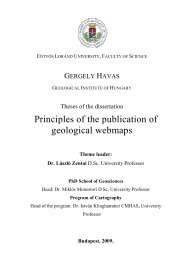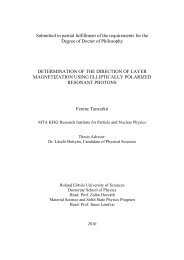Graph Polynomials and Graph Transformations in ... - ELTE TTK TEO
Graph Polynomials and Graph Transformations in ... - ELTE TTK TEO
Graph Polynomials and Graph Transformations in ... - ELTE TTK TEO
You also want an ePaper? Increase the reach of your titles
YUMPU automatically turns print PDFs into web optimized ePapers that Google loves.
1. IntroductionIn the center of the dissertation graph polynomials <strong>and</strong> graph transformations st<strong>and</strong>,their role <strong>in</strong> algebraic <strong>and</strong> extremal graph theoretic problems. The algebraic graph theoryhas a long history due to its <strong>in</strong>timate relationship with chemistry <strong>and</strong> (statistical)physics. In these fields one often describe a system, state or a molecule by an appropriateparameter. Then it rises the purely mathematical question whether what the extremalvalues of this parameter are. In the dissertation we give some general methods to attackthese k<strong>in</strong>ds of extremal problems. In the first, bigger half of the dissertation we studytwo graph transformations, the so-called Kelmans transformation <strong>and</strong> the generalized treeshift <strong>in</strong>troduced by the author. The Kelmans transformation can be applied to all graphs,while one can apply the generalized tree shift only for trees. The importance of thesetransformations lies <strong>in</strong> the fact that surpris<strong>in</strong>gly many natural graph parameters <strong>in</strong>crease(or decrease) along these transformations. This way we ga<strong>in</strong> a considerable <strong>in</strong>formationabout the extremal values of the studied parameter.In the second half of the dissertation we study a purely extremal graph theoretic problem,the so-called density Turán problem which, however, turn out to be strongly relatedto algebraic graph theory <strong>in</strong> several ways. As a by-product of the efforts we did to solvethe problem we give a solution to a longst<strong>and</strong><strong>in</strong>g open problem concern<strong>in</strong>g trees hav<strong>in</strong>gonly <strong>in</strong>teger eigenvalues.2. Notations <strong>and</strong> basic def<strong>in</strong>itionsBefore we start to survey our results, we <strong>in</strong>troduce the most important notations.We will follow the usual notation: G is a simple graph, V (G) is the set of its vertices,E(G) is the set of its edges. In general, |V (G)| = n <strong>and</strong> |E(G)| = e(G) = m. We willuse the notation N(x) for the set of the neighbors of the vertex x, |N(v i )| = deg(v i ) = d idenote the degree of the vertex v i . We will also use the notation N[v] for the closedneighborhood N(v) ∪ {v}. The complement of the graph G will be denoted by G.K n will denote the complete graph on n vertices, meanwhile K n,m the complete bipartitegraph with color classes of size n <strong>and</strong> m. Let P n <strong>and</strong> S n denote the path <strong>and</strong> the star onn vertices, respectively.Let M 1 <strong>and</strong> M 2 be two graphs with dist<strong>in</strong>guished vertices u 1 ,u 2 of M 1 <strong>and</strong> M 2 , respectively.Let M 1 : M 2 be the graph obta<strong>in</strong>ed from M 1 ,M 2 by identify<strong>in</strong>g the vertices of u 1<strong>and</strong> u 2 . So |V (M 1 : M 2 )| = |V (M 1 )| + |V (M 2 )| − 1 <strong>and</strong> E(M 1 : M 2 ) = E(M 1 ) ∪ E(M 2 ).Note that this operation depends on the vertices u 1 ,u 2 , but <strong>in</strong> general we do not <strong>in</strong>dicateit <strong>in</strong> the notation.The matrix A(G) will denote the adjacency matrix of the graph G, i.e., A(G) ij is thenumber of edges go<strong>in</strong>g between the vertices v i <strong>and</strong> v j . S<strong>in</strong>ce A(G) is symmetric, itseigenvalues are real <strong>and</strong> we will denote them by µ 1 ≥ µ 2 ≥ · · · ≥ µ n . We will also usethe notation µ(G) for the largest eigenvalue <strong>and</strong> we will call it the spectral radius of thegraph G. The characteristic polynomial of the adjacency matrix will be denoted byn∏φ(G,x) = det(xI − A(G)) = (x − µ i ).We will simply call it the adjacency polynomial.i=11



